Written by Sig Silber
HEADLINES (Up-dated 7:58 pm EDT) –
“– Heavy rainfall & flash flooding potential across portions of the Plains, Middle Mississippi Valley, and Tennessee Valley through the remainder of the week
– Searing heat in the West both Thursday & Friday, elevated fire weather risk in the Northwest on Thursday; hot Thursday in the Northeast
– Potential Tropical Cyclone Nine expected to track through the Greater Antilles the second half of the week”

This article provides continuous updates for a variety of Weather and Weather-Related Threats as well as a general weather forecast. These are “Live” maps that continually update. Please pay attention to the Mesoscale Events maps — Mesoscale Events are potentially life-threatening situations.
Please share this article – Go to the very top of the page, right-hand side for social media buttons. Also, feel free to send this email to anyone you feel will benefit from it
Readers can scan through this article or jump to where they want to go via the links to the right. To get back to the Directory, hit the back arrow at the top of the URL bar on your screen. But in many cases, one of my Editors has graciously inserted a Return to Directory link to click so that is even easier. This is so high tech that I hardly believe it. |
|
CONUS Focal Points
Short Range Focal Points
Short Range Forecast Discussion NWS Weather Prediction Center College Park MD 359 PM EDT Wed Jul 29 2020
Valid 00Z Thu Jul 30 2020 – 00Z Sat Aug 01 2020
…Heavy rainfall & flash flooding potential across portions of the Plains, Middle Mississippi Valley, and Tennessee Valley through the remainder of the week…
…Searing heat in the West both Thursday & Friday, elevated fire weather risk in the Northwest on Thursday; hot Thursday in the Northeast…
…Potential Tropical Cyclone Nine expected to move into the Bahamas on Friday…
A series of frontal boundaries and an upper level trough will become responsible for an onslaught of heavy rainfall and thunderstorms from the central High Plains to the central Appalachians through Friday. This evening, a stalled frontal over the Ohio Valley and another one over the Midwest look to generate areas of showers and storms over the Nation’s Heartland this evening. Slight Risks for both severe storms and flash flooding have been posted in parts of the Central Plains and Middle Mississippi Valley. By Thursday, the upper level trough makes its way over the Central Plains with the stalled front over the Ohio Valley making little effort to exit the region. This means more heavy rain and thunderstorms across the east-central U.S. and southern Appalachians. A slight risk for flash flooding is forecast in these areas along with a continued chance for severe storms. By Friday, the front over the Ohio Valley sags south into the Mid-South where more rounds of heavy showers are on tap along with the concerns for flash flooding and severe storms. A cold front passing into the Southern Plains may also trigger some strong-to-severe storms across the region Friday evening. Cooler than normal temperatures are expected across the Central Plains the remainder of the week.
Sizzling heat has taken hold of the Northwest, Great Basin, and Southwest with afternoon temperatures soaring into the triple digits across the interior valleys on Thursday and Friday as a large upper level ridge strengthens across the western states. Record high temperatures are possible and excessive heat warnings are in effect across portions of these regions along with heat advisories in Southern California. In addition, the Storm Prediction Center is concerned about dry thunderstorms forming in the Northwest that would lead to a risk of fire weather due to their associated lightning and lack of rainfall on this evening and Thursday. Red flag warnings remain in effect for this area. Abnormally hot conditions are also expected to stick around the Northeast through Thursday before a cold front ushers in slightly cooler conditions for Friday.
All eyes remain fixed on Potential Tropical Cyclone Nine in the eastern Caribbean Sea this afternoon as it tracks towards the Greater Antilles later this week. Showers and thunderstorms associated with this system could reach parts of South Florida by the start of the weekend. Please visit the National Hurricane Center for the latest advisories on Potential Tropical Cyclone Nine.
We try to keep this up to date but if is not you can find the updated version here.
When you click on this image it takes you to the SPC Fire Warning Page and you get a set of maps for Days 1, 2, 3 – 8, etc. You can then click on those for more detailed information. The map is a bit blurry as I tried to make it a bit larger than the map provided by NOAA but should be able to see where the current wildfire risks are. But if you click on this map, you will get to see three maps that show the risk for different time periods.
Thunderstorm Risk
This should play out something like shown in this 60 Hour Forecast Animation
Here is a national animation of weather fronts and precipitation forecasts with four 6-hour projections of the conditions that will apply covering the next 24 hours and a second day of two 12-hour projections the second of which is the forecast for 48 hours out and to the extent it applies for 12 hours, this animation is intended to provide coverage out to 60 hours. Beyond 60 hours, additional maps are available at links provided below. The explanation for the coding used in these maps, i.e. the full legend, can be found here although it includes some symbols that are no longer shown in the graphic because they are implemented by color-coding.

The two maps below break it down by day and may be easier to read.
Now, the Day One and Two CONUS Forecasts: These Maps Update Daily.
Day One CONUS Forecast | Day Two CONUS Forecast |
These graphics update and can be clicked on to enlarge. You can see where the weather will be | |
 | |
During the winter much of our weather originates in the Pacific. That is why we pay attention to the near-term history of storms arriving.
Temperature

A version that shows a 20 hour animation and some other views can be found here OR SIMPLY CLICK ON THE IMAGE.
– Return to Directory
Day 3 – 7 Hazards
Hazards:
– Heavy rain across portions of the Southeast as well as the lower Great Lakes, Sat-Sun, Aug 1-Aug 2.
– Heavy rain possible along much of the Eastern Seaboard up into New England, Mon-Wed, Aug 3-Aug 5.
– Flooding possible across portions of the central and northern Plains.
– Flooding occurring or imminent across portions of the central and northern Plains.
– Excessive heat across portions of the Desert Southwest, Sat-Sun, Aug 1-Aug 2.
– High winds across portions of Florida, Sat-Mon, Aug 1-Aug 3.
– Heavy rain possible across portions of eastern Alaska, Sun, Aug 2.
– Heavy rain possible across portions of coastal southern Alaska, Sat-Mon, Aug 1-Aug 3.
– Heavy rain possible across portions of the Alaskan Panhandle, Tue-Wed, Aug 4-Aug 5.Detailed Summary:
For the medium range period (Saturday, August 1 – Wednesday, August 5), the eastern U.S. should become the main area of concern as a potential tropical cyclone could track across the region. The initial setup over the eastern U.S. will be an omega blocking pattern over Canada with a positively-tilted longwave trough lingering across the eastern-central U.S. A wave of low pressure forming along the associated frontal boundary should lead to heavy rain across the lower Great Lakes during the weekend, as Potential Tropical Cyclone Nine (PTC 9) is forecast to track up the vicinity of Florida Peninsula at tropical storm intensity. Forecast uncertainty increases further for early next week as PTC 9 could track further up the East Coast or moving more slowly farther south. The heavy rain area assumes some form of interaction between PTC 9 and a slow-moving frontal boundary that extends into New England. Please consult the National Hurricane Center for the latest updates on PTC 9.
Meanwhile, an upper-level ridge will remain a dominant feature over the western U.S. Temperatures should be about 5 to 10 degrees above normal across much of the interior western U.S. before an upper trough brings cooler air into the Pacific Northwest and the northern Rockies by early next week. High temperatures are expected to reach 115 degrees in the Desert Southwest during the weekend before moderating slightly by early next week. Over the northern and central Plains, much cooler than normal temperatures will remain in place behind the aforementioned slow-moving longwave trough.
Over Alaska, the pattern appears to get more active during the medium-range period as a couple of significant occluded cyclones are forecast to impact the southern periphery of the state. The more active pattern also brings more uncertainty into the forecast. Nevertheless, heavy rain is possible near the southern coastal sections of Alaska from late Saturday into Monday as the first occluded cyclone edges into the Gulf of Alaska. By early next week, the next wave of moisture associated with the second occluded system should bring the threat of heavy rain farther south across portions of the Alaskan Panhandle.
(This is updated only during the week) Note the first list is weather highlights, this list is hazards. Not sure there is that much of a difference but they come from two different parts of NOAA. The Day 3 – 7 Hazards List does not update on weekends. But it is still useful as it remains valid for the period of time it covers. Of course, all forecasts are subject to change. Later we show a map of the hazards. Perhaps we should show them together.
Click here for the latest complete Day 3 -7 Hazards forecast which updates only on weekdays. It includes the full discussion which I do not update in this article but only present the highlights.
– Return to Directory
Ski Snow Reports
We will resume more detailed coverage when the summer is over.
– Return to Directory
Tropical Events
This is now beyond the time of the year we pay special attention to Tropical Events other than the Western Pacific.
So I am replacing the large with three small maps but you can click on them to get larger versions. Even though they are small maps you should be able to tell if there is activity and If I see activity I will make the map where there is activity full size.
| the Central Pacific. | the Eastern Pacific | the Atlantic and the Gulf of Mexico |
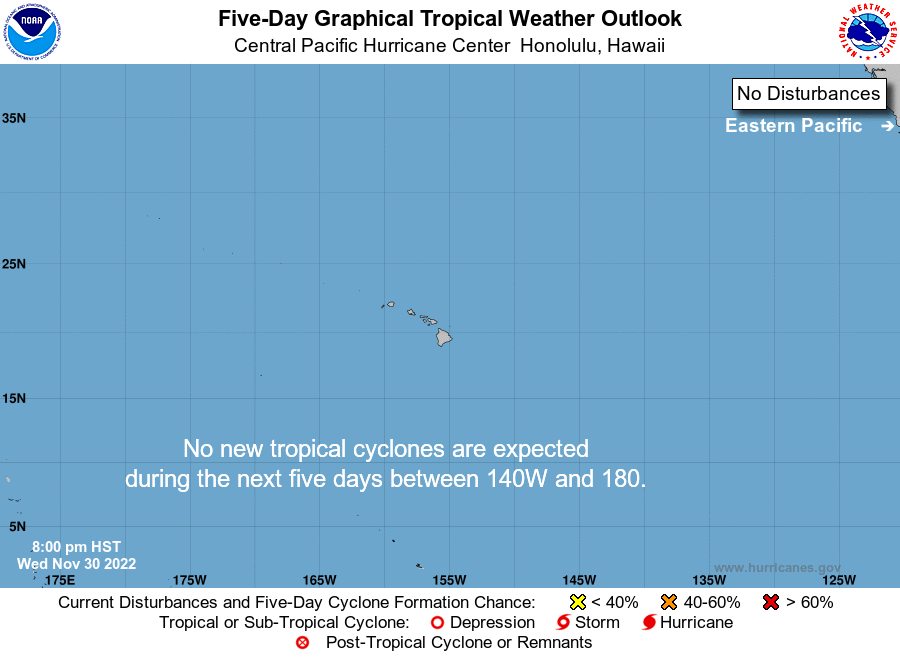 | 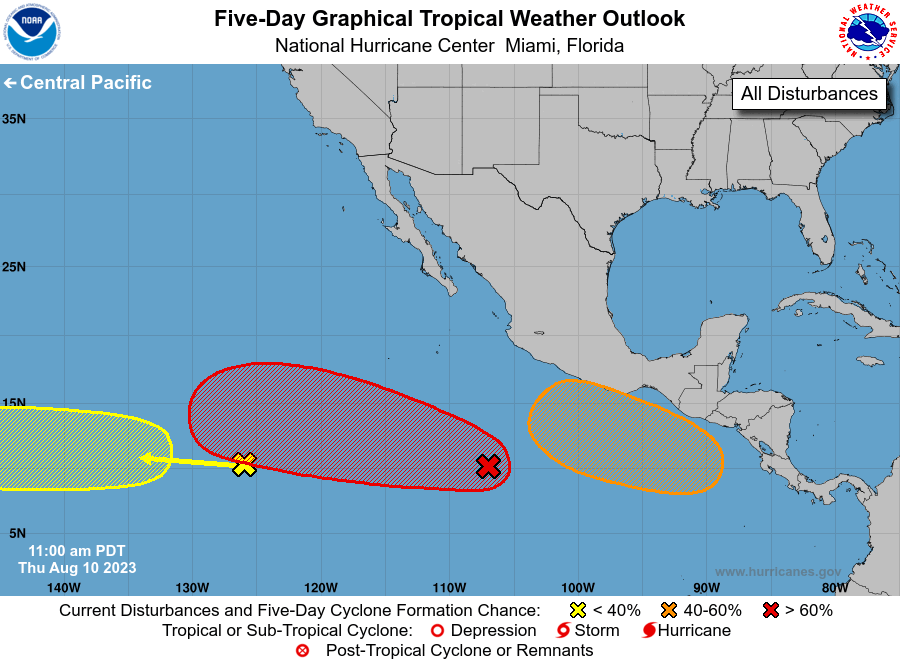 |  |

![[Image of probabilities of 34-kt winds]](https://www.nhc.noaa.gov/storm_graphics/AT09/refresh/AL092020_wind_probs_34_F120+png/145151.png)
Updates on individual named storms can be obtained here.
And the Western Pacific

Week Tropical Forecast

– Return to Directory
Intermediate-Term Weather Forecast
And shifting to the Alaska and CONUS Intermediate-Term Weather Forecast showing from left to right, Days 1- 5, 6 – 10, 8 – 14 and Weeks 3 – 4 You can click on these maps to have them enlarge, there are larger versions in the Addendum (More Weather the link is shown at the end of this section, and there are larger versions of these maps in the Addendum. Also, the discussions that go with these forecast maps can be found here (first two weeks) and here (Weeks 3 and 4).
First Temperature
And then Precipitation
For those interested in more detail, there are additional weather maps and information in the MORE WEATHER Addendum. The link to the Addendum is here. |
– Return to Directory
Mesoscale Events
The following map shows where mesoscale events are occurring or forecast. If you do not see any areas highlight on this map than there are no mesoscale events taking place or forecast. A mesoscale event is a very serious situation for a very small area and detailed information is provided for these events when they occur or are forecast. If a mesoscale event is shown, click on the map and more detail on the event will be shown.
Two different parts of the NWS issue this map and they are not always in agreement although they are pretty close. They (Norman Oklahoma and College Park Maryland) issue the alerts when they realize the need, so it is best to look on both maps and click one or both if you see areas highlighted.
This next map showing where “Headlines” have been issued for convection (and an animation of the recent movement of storms) should update and you should be able to click on to get additional details but if it does not update when you click on it, click here.
There is a slight difference between convection and thunderstorms. The below map shows where “Headlines” have been issued for Thunderstorms. You should be able to click on the map to get additional details but if it does not update, you can click here.
The map below shows the current wildfire risk which becomes more significant as we move into Summer. When you click on this image it takes you to the SPC Fire Warning Page and you get a set of maps for Days 1, 2, 3 – 8, etc. You can then click on those for more detailed information. The map is a bit blurry as I tried to make it a bit larger than the map provided by NOAA but should be able to see where the current wildfire risks are. But if you click on this map, you will get to see three maps that show the risk for different time periods.
– Return to Directory
Now the Day 3 – 7 Hazards Outlook Maps

The orange and red outlined areas are what is most concerning of the forecasted Day 3 – 7 Hazards. This graphic does not update during the weekend. There is a discussion that goes with this graphic and you can access that discussion here.
The following is provided to help the reader relate the maps to how NWS will describe an area of the U.S.

– Return to Directory
Now to our More Detailed Weather Report
This graphic is about Atmospheric Rivers i.e. thick concentrated movements of water moisture. More explanation on Atmospheric Rivers can be found by clicking here or if you want more theoretical information by clicking here. The idea is that we have now concluded that moisture often moves via narrow but deep channels in the atmosphere (especially when the source of the moisture is over water) rather than being very spread out. This raises the potential for extreme precipitation events.
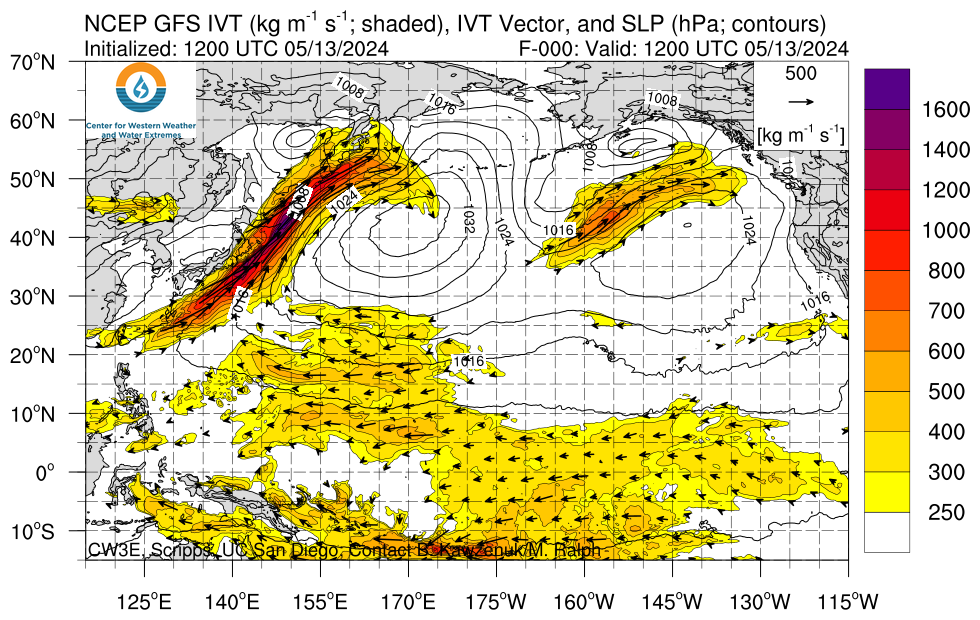
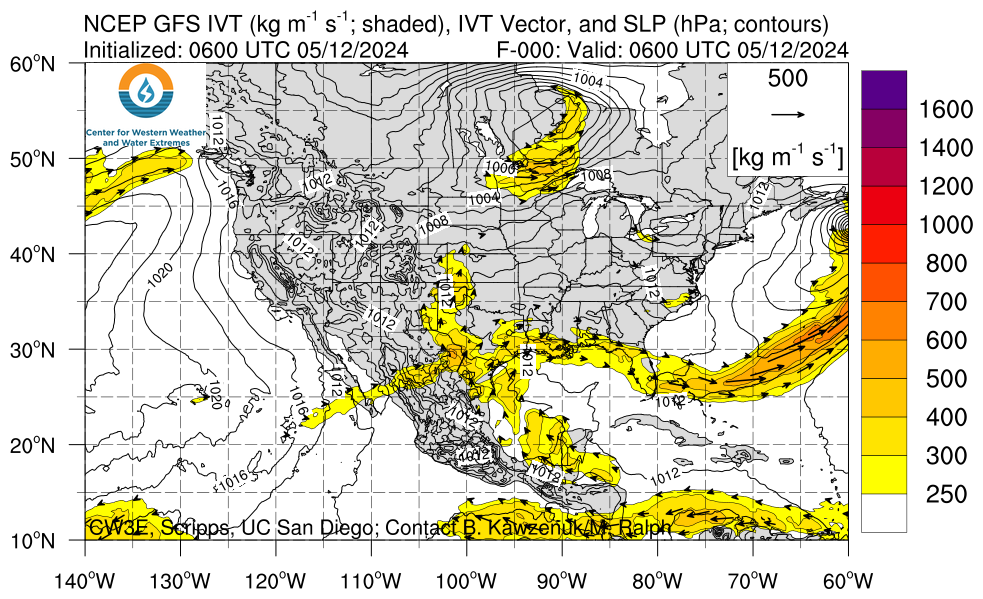
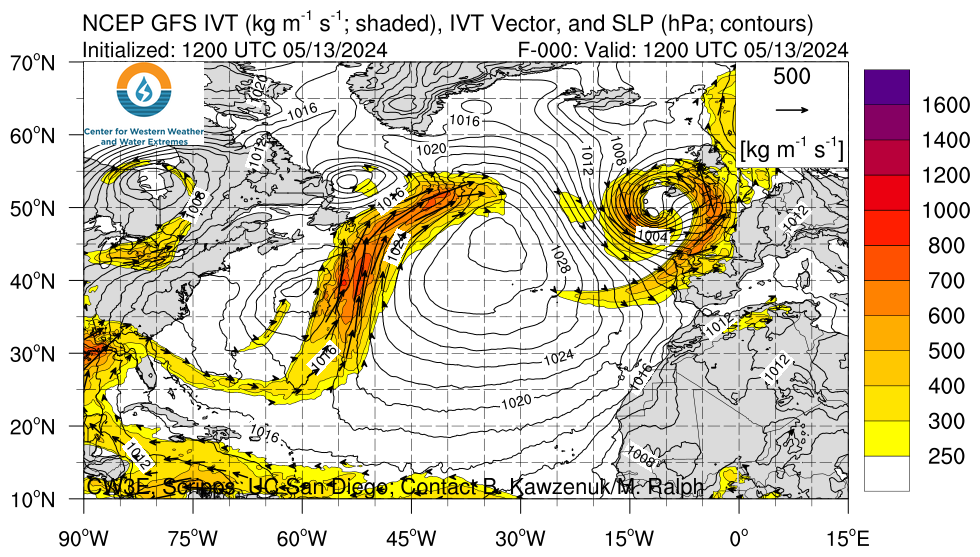
500 MB Mid-Atmosphere View
The map below is the mid-atmosphere 3-Day chart rather than the surface highs and lows and weather features. In some cases, it provides a clearer less confusing picture as it shows only the major pressure gradients. This graphic auto-updates so when you look at it you will see NOAA’s latest thinking. The speed at which these troughs and ridges travel across the nation will determine the timing of weather impacts. This graphic auto-updates I think every six hours and it changes a lot. Thinking about clockwise movements around High-Pressure Systems and counterclockwise movements around Low-Pressure Systems provides a lot of information.


| Day 3 Above, 6 Below | Day 4 Above,7 Below | Day 5 Above. |
 |  |  |
 |  |  |
Here are the precipitation forecasts. First the cumulative for Days 1 – 3

Then cumulative for Days 1 – 5
Then cumulative for Days 1 – 7

Now we look at the forecast for the Maximum Temperature three days out.
Looking ahead to next week.

– Return to Directory
Additional Tools to Obtain Watches and Warnings
| Current watches, warnings, and advisories issued by the agencies of the National Weather Service. Hazards should show up in the various maps but the below links will take you to all outstanding watches and warnings in each category which may include some categories not covered in the various maps or difficult to find. So if there is a category of interest, click on the appropriate link below. |
|
Below you will see a number of different maps that are updated in real-time, making this a “live” report. If a part of one or more of the maps shows an area that is highlighted, you can click on it and get the full current report. By having the reader click on these active situations rather than having GEI do so, you will not miss any events in which you might have an interest and which we had not noticed and the page will not get cluttered with warnings, etc that have since expired.
Our focus here is events that are likely to last in the range of six hours but there can be longer or shorter events that are addressed by the Storm Prediction Center which is the main source of the information in this article. Long-term major events like a Hurricane are more likely to be in a separate article. But that may not always be the case. Since in general, all the links on this page transfer you into the NOAA system, in order to get back into this article you need to either close the tab to which you were transferred or click back on the tab that has this article.
| Live Warning Maps which If Severe Weather is Shown can be Clicked on to get more detail about these events. If there is a current warning shown on the map, click on the map for additional information related to the event. | These maps are updated as risks are identified. |
| This is the current graphic showing any mesoscale discussions (MD’s) which are in effect over the contiguous United States. Please read the description of the purpose of our MD’s for further information. Details on all valid MD’s may be found on our Current Mesoscale Discussions page. |  |
| Convective Outlooks | |
|---|---|
| This is today’s forecast for organized severe thunderstorms over the contiguous United States. Please read the description of the risk categories for further information. You may find the latest Day 1 Outlook available as well as all Outlooks issued today online. | Today’s Outlook |
 | |
| This is tomorrow’s forecast for organized severe thunderstorms over the contiguous United States. Please read the description of the risk categories for further information. The latest Day 2 Outlook is available as well as all Outlooks that have been issued today. | Tomorrow’s Outlook |
 | |
| This is the day after tomorrow’s (day 3) forecast for organized severe thunderstorms over the contiguous United States. Please read the description of the risk categories for further information. The latest Day 3 Outlook is available as well as all Outlooks that have been issued today. | Day 3 Outlook |
 | |
| This is the day 4-8 forecast for organized severe thunderstorms over the contiguous United States. The latest Day 4-8 Outlook is available as well as all Outlooks that have been issued today. Note: A severe weather area depicted in the Day 4-8 period indicates a 30% or higher probability for severe thunderstorms (e.g. a 30% chance that a severe thunderstorm will occur within 25 miles of any point). | Day 4-8 Outlook |
 | |
| The Thunderstorm Outlooks depict the probability of thunderstorms across the contiguous United States in 4 or 8 hour time periods. The probabilistic forecast directly expresses the best estimate of a thunderstorm occurring within 12 miles of a point. The three probabilistic forecast thresholds are 10, 40, and 70 percent. | Thunderstorm Outlook |
 | |
| Fire Weather Outlooks | |
| This is today’s forecast for organized wildfires over the contiguous United States. Please read the description of the risk categories for further information about this product. | Today’s Outlook |
 | |
| This is tomorrow’s forecast for organized wildfires over the contiguous United States. Please read the description of the risk categories for further information about this product. | Tomorrow’s Outlook |
 | |
| This is day 3-8 forecast for organized wildfires over the contiguous United States. Please read the description of the risk categories for further information about this product. | Day 3-8 Outlook |
 | |
























